This set of Basic Heat Transfer Operations Questions and Answers focuses on “Condensers in Refrigeration – 2”.
1. In a shell and coil type water cooled condenser, the refrigerant is passed through the ________
a) Coil
b) Shell
c) Tube
d) Annulus
View Answer
Explanation: The refrigerant having lesser pressure drop is always considered to be kept at the annulus side of the double pipe setup, hence the cooling water in the inner tube as it faces larger pressure drops and in the tube side of as Shell-and-tube type setup.
2. Recognize the following water cooled condenser.
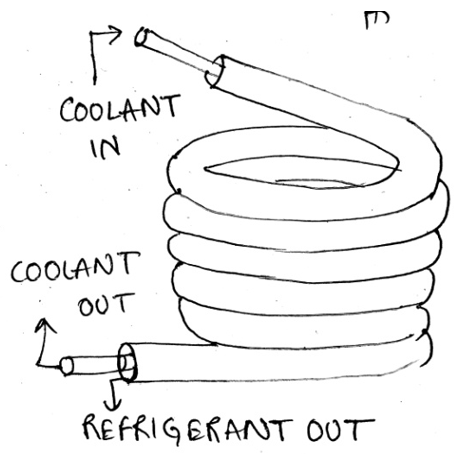
a) Shell tube
b) Double tube condenser
c) Tube coil
d) Shell coil
View Answer
Explanation: As shown in the figure, these condensers have the cold water flowing through the inner tube while the refrigerant flows through the annulus in counter flow direction. The refrigerant in the annulus tube also rejects a part of its heat to the open surroundings by free convection.
3. Recognize the following water cooled condenser.
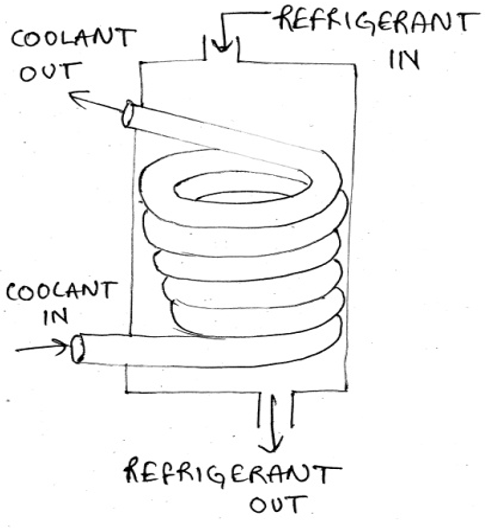
a) Shell and Tube condenser
b) Double tube condenser
c) Shell and coil type condenser
d) Plate-type condenser
View Answer
Explanation: The water flows in the coils, which usually has fins to augment the heat transfer coefficient. The refrigerant usually flows through the shell side of the setup while in the case of smaller capacity condensers water is the one that flows in the shell.
4. In evaporative condensers, ___________ used to extract heat from the condensing refrigerant.
a) Air is
b) Both air and water are
c) Water is
d) Either air or water is
View Answer
Explanation: In evaporative condensers, the two mediums undergoing evaporation and heating are water and air, hence the setup should always have water and air both simultaneously.
5. Evaporative condensers combine the features of a _____________ in a single unit.
a) Cooling tower and water-cooled condenser
b) Falling tower and water-cooled condenser
c) Cooling tower and Air condenser
d) Rising film tower and water-cooled condenser
View Answer
Explanation: Evaporative condensers are used in places where water is scarce or limited. Since water is used in a closed setup, only a small part of the water evaporates while the rest is retained and hence the cooling towers and water-cooled condenser are used together to minimise the water loss.
6. Evaporative condensers are used in places where water is _________
a) Scarce
b) Plenty
c) Moderately available
d) Sufficient
View Answer
Explanation: Evaporative condensers are used in places where water is scarce or limited. Since water is used in a closed setup, only a small part of the water evaporates while the rest is retained and hence the cooling towers and water-cooled condenser in a single unit are used together to minimise the water loss.
7. What is the meaning of heat rejection ratio (HRR) of a condenser?
a) Ratio of heat rejected to the heat absorbed
b) Ratio of heat absorbed to the heat rejected
c) Ratio of heat required to the heat lost
d) Ratio of heat wasted in a cycle to the heat absorbed
View Answer
Explanation: The heat rejection ratio (abbreviated as HRR) is the ratio of the amount of heat rejected to the amount of heat absorbed (also known as refrigeration capacity), which is,
HRR = Qc /Qe
8. What is the relation between heat rejection ratio (HRR) and Coefficient of performance (COP)?
a) HRR = 1 + 1/COP
b) HRR = 1+ COP
c) HRR = COP/2
d) HRR = 1/COP
View Answer
Explanation: HRR=\(\frac{Qc}{Qe}=\frac{Qe+Wc}{Qe}=1+\frac{1}{COP}\) is the required relation.
9. What is the equation for Coefficient of performance of a condenser?
a) COP = Qe/Qc
b) COP = We/Qc
c) COP = Wc/Qe
d) COP = Qe/Wc
View Answer
Explanation: The coefficient of performance is technically equal to the ratio of Heat absorbed Qe to the work done Wc.
10. Which one of the following correctly represents the condensation process in a condenser?
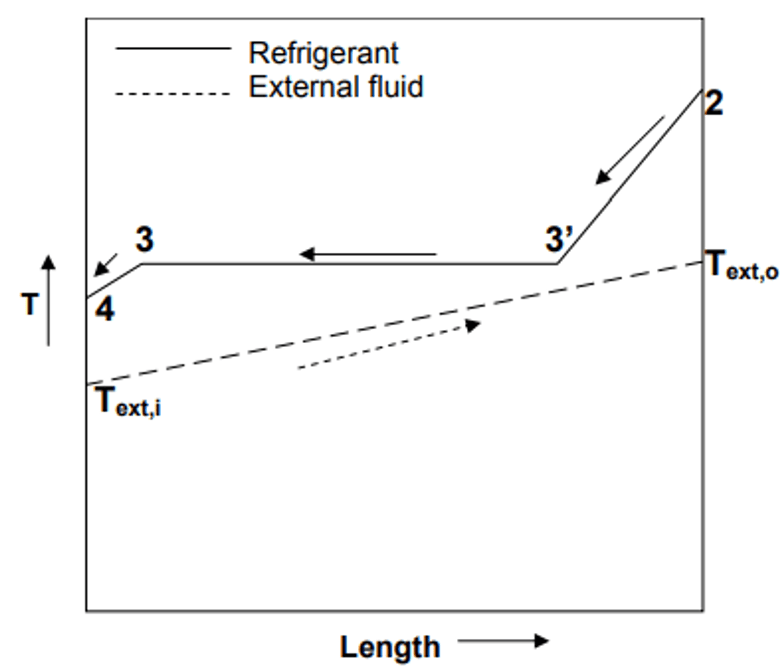
a) 2-3’-3-4
b) 3’-3
c) 3-4
d) 2-3’-3
View Answer
Explanation: The process 2-3’-3-4 is the cumulative heat rejection process with
2-3’ = Superheated steam cooling
3’-3 = Condensation
3-4 = Cooling of condensate
11. Which one of the following is correct representation of Fin efficiency curve for an annular fin?
a) 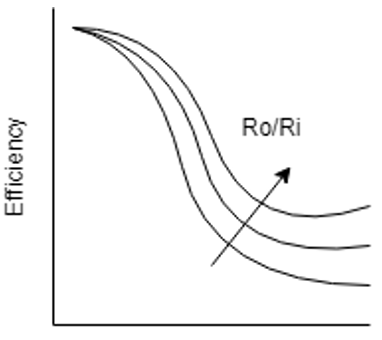
b) 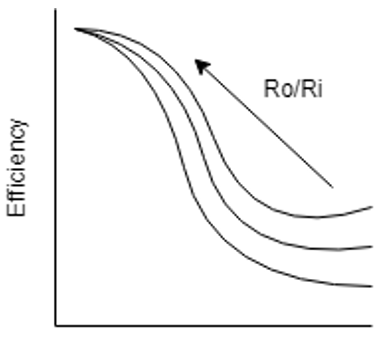
c) 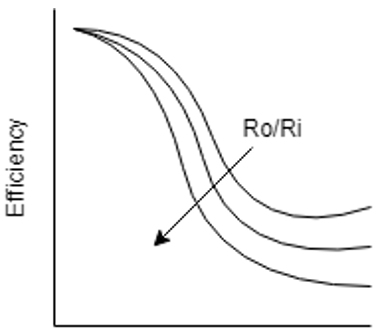
d) 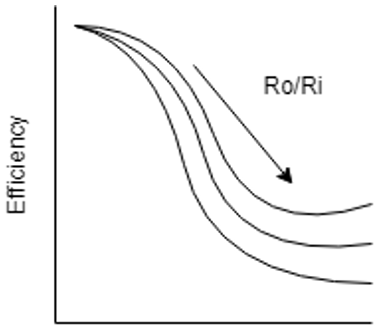
View Answer
Explanation: The Figure is the description of the typical efficiency curve for fins where the terms Ro and Ri are the outer and inner radius of the annular fin, the Abscissa is \(\frac{Ro-Ri}{\sqrt{\frac{h}{kt}}}\) h is the external heat transfer coefficient, k is the thermal conductivity of fin material and t is the thickness of the fin.
12. The Grimson’s correlation gives the set of parameters to be used to calculate the Nusselt number for the calculation of the heat transfer coefficient as Nu = C Ren Pr0.33.
a) True
b) False
View Answer
Explanation: Yes, the given statement is right because the set of parameters given by Grimson.
| Reynolds Number, Re | Constant C | Constant n |
|---|---|---|
| 0.4 to 4 | 0.989 | 0.33 |
| 4 to 40 | 0.911 | 0.385 |
| 40 to 4000 | 0.683 | 0.466 |
| 40000 to 400000 | 0.0266 | 0.805 |
Sanfoundry Global Education & Learning Series – Heat Transfer Operations.
To practice basic questions and answers on all areas of Heat Transfer Operations, here is complete set of 1000+ Multiple Choice Questions and Answers.
If you find a mistake in question / option / answer, kindly take a screenshot and email to [email protected]
- Practice Chemical Engineering MCQs
- Check Heat Transfer Operations Books
- Check Chemical Engineering Books
- Apply for Chemical Engineering Internship
